#March 18 1913
Explore tagged Tumblr posts
Text

Η κηδεία του Βασιλιά Γεωργίου του 'Α στην Αθήνα στις 20 Μαρτίου 1913.
Στις 18 Μαρτίου 1913, ο Γεώργιος Α΄ θέλοντας να επισκεφτεί για εθιμοτυπικούς λόγους το Γερμανό ναύαρχο Γκόπφεν, κατέβηκε στην αποβάθρα του Λευκού Πύργου. Μαζί του ήταν και ο υπασπιστής του, ταγματάρχης Φραγκούδης. Σε μια συμβολή της οδού Βασιλίσσης Όλγας, ο Αλέξανδρος Σχινάς πλησίασε και από μικρή απόσταση πυροβόλησε καίρια το Γεώργιο. Έπειτα, προσπάθησε να πυροβολήσει και τον υπασπιστή του, αλλά εκείνος πρόλαβε και τον αφόπλισε. Ο Σχινάς συνελήφθη από δυο χωροφύλακες, που βρίσκονταν στο σημείο και ανακρίθηκε. Στις 6 Μαΐου, σύμφωνα με την επίσημη εκδοχή, αυτοκτόνησε πηδώντας από το παράθυρο του τμήματος της χωροφυλακής, όπου κρατούταν.
Η κατάθεσή του δε δόθηκε ποτέ στη δημοσιότητα. Οι φάκελοι της ανάκρισης φαίνεται πως κάηκαν όταν στο ατμόπλοιο «Ελευθερία», που τους μετέφερε στον Πειραιά, εκδηλώθηκε πυρκαγιά. Η πυρκαγιά κατέστρεψε κυρίως την καμπίνα όπου φυλάσσονταν οι προανακριτικοί φάκελοι. Πίσω από τη δολοφονία του Βασιλιά πιστεύεται ότι κρυβόταν η Γερμανία, αφού ο Γεώργιος δεν ήταν υποστηρικτής της. Η θεωρία αυτή στηρίζεται με το γεγονός ότι οι Γερμανοί ήθελαν να ανεβεί στον ελληνικό θρόνο ο φιλικά προσκείμενος Κωνσταντίνος.
Λιθογραφία του Σωτήρη Χρηστίδη (1858-1940)
Greek lithograph depicting the funeral of the assassinated King George I of Greece at Athens on 20 March 1913
#λιθογραφία#Γεώργιος Ά#Αθήνα#1913#δολοφονία#πολιτική#ιστορία#Ελλάδα#lithograph#funeral#King George I of Greece#assassination#March 18 1913#politics#history#royals#Europe
2 notes
·
View notes
Text


Band of Brothers Birthdays
January
1 John S. Zielinski Jr. (b. 1925)
21 Richard D. “Dick” Winters (b. 1918)
26 Herbert M. Sobel (b. 1912)
30 Clifford Carwood "Lip" Lipton (b. 1920)
31 Warren H. “Skip” Muck (b. 1922) & Robert B. Brewer (b. 1924)
February
8 Clarence R. Hester (b. 1916)
18 Thomas A. Peacock (b. 1920)
23 Lester A. “Les” Hashey (b. 1925)
March
1 Charles E. “Chuck” Grant (b. 1922)
2 Colonel Robert L. “Bob” Strayer (b. 1910)
4 Wayne “Skinny” Sisk (b. 1922)
10 Frank J. Perconte (b. 1917)
13 Darrell C. “Shifty” Powers (b. 1923)
14 Joseph J. “Joe” Toye (b. 1919)
24 John D. “Cowboy” Halls (b. 1922)
26 George Lavenson (b. 1917) & George H. Smith Jr. (1922)
27 Gerald J. Loraine (b. 1913)
April
3 Colonel Robert F. “Bob” Sink (b. 1905) & Patrick S. “Patty” O’Keefe (b. 1926)
5 John T. “Johnny” Julian (b. 1924)
10 Renée B. E. Lemaire (b. 1914)
11 James W. Miller (b. 1924)
15 Walter S. “Smokey” Gordon Jr. (b. 1920)
20 Ronald C. “Sparky” Speirs (b. 1920)
23 Alton M. More (b. 1920)
27 Earl E. “One Lung” McClung (b. 1923) & Henry S. “Hank” Jones Jr. (b. 1924)
28 William J. “Wild Bill” Guarnere (b. 1923)
May
12 John W. “Johnny” Martin (b. 1922)
16 Edward J. “Babe” Heffron (b. 1923)
17 Joseph D. “Joe” Liebgott (b. 1915)
19 Norman S. Dike Jr. (b. 1918) & Cleveland O. Petty (b. 1924)
25 Albert L. "Al" Mampre (b. 1922)
June
2 David K. "Web" Webster (b. 1922)
6 Augusta M. Chiwy ("Anna") (b. 1921)
13 Edward D. Shames (b. 1922)
17 George Luz (b. 1921)
18 Roy W. Cobb (b. 1914)
23 Frederick T. “Moose” Heyliger (b. 1916)
25 Albert Blithe (b. 1923)
28 Donald B. "Hoob" Hoobler (b. 1922)
July
2 Gen. Anthony C. "Nuts" McAuliffe (b. 1898)
7 Francis J. “Frank” Mellet (b. 1920)
8 Thomas Meehan III (b. 1921)
9 John A. Janovec (b. 1925)
10 Robert E. “Popeye” Wynn (b. 1921)
16 William S. Evans (b. 1910)
20 James H. “Moe” Alley Jr. (b. 1922)
23 Burton P. “Pat” Christenson (b. 1922)
29 Eugene E. Jackson (b. 1922)
31 Donald G. "Don" Malarkey (b. 1921)
August
3 Edward J. “Ed” Tipper (b. 1921)
10 Allen E. Vest (b. 1924)
15 Kenneth J. Webb (b. 1920)
18 Jack E. Foley (b. 1922)
26 Floyd M. “Tab” Talbert (b. 1923) & General Maxwell D. Taylor (b. 1901)
29 Joseph A. Lesniewski (b. 1920)
31 Alex M. Penkala Jr. (b. 1924)
September
3 William H. Dukeman Jr. (b. 1921)
11 Harold D. Webb (b. 1925)
12 Major Oliver M. Horton (b. 1912)
27 Harry F. Welsh (b. 1918)
30 Lewis “Nix” Nixon III (b. 1918)
October
5 Joseph “Joe” Ramirez (b. 1921) & Ralph F. “Doc” Spina (b. 1919) & Terrence C. "Salty" Harris (b. 1920)
6 Leo D. Boyle (b. 1913)
10 William F. “Bill” Kiehn (b. 1921)
15 Antonio C. “Tony” Garcia (b. 1924)
17 Eugene G. "Doc" Roe (b. 1922)
21 Lt. Cl. David T. Dobie (b. 1912)
28 Herbert J. Suerth Jr. (b. 1924)
31 Robert "Bob" van Klinken (b. 1919)
November
11 Myron N. “Mike” Ranney (b. 1922)
20 Denver “Bull” Randleman (b. 1920)
December
12 John “Jack” McGrath (b. 1919)
31 Lynn D. “Buck” Compton (b. 1921)
Unknown Date
Joseph P. Domingus
Richard J. Hughes (b. 1925)
Maj. Louis Kent
Father John Mahoney
George C. Rice
SOURCES
Military History Fandom Wiki
Band of Brothers Fandom Wiki
Traces of War
Find a Grave
#this is going off who was on on the show#i double checked the dates and such but if you notice any mistakes please let me know :)#band of brothers#easy company#hbo war#not gonna tag everyone lol#mine: misc#yep it's actually Halls and not Hall#i've seen Terrence Harris's name spelled with as Terence but wenand t with two Rs s#since that's how it's spelled on photos of memorials and on his gravestone#I’ll do the pacific next! should be significantly shorter since there’s far fewer characters 😅
183 notes
·
View notes
Text

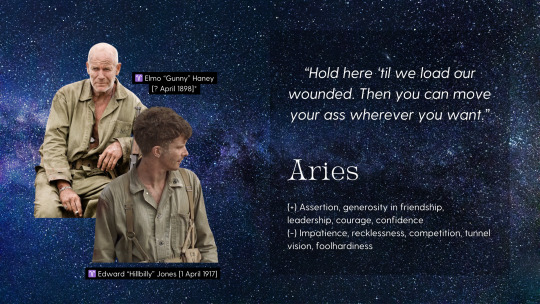

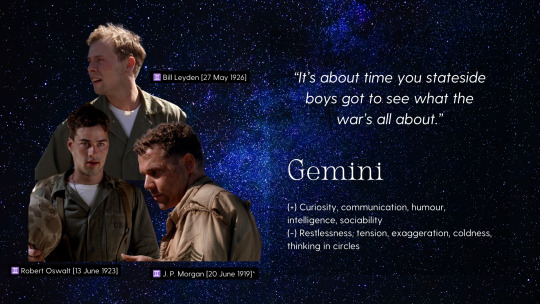





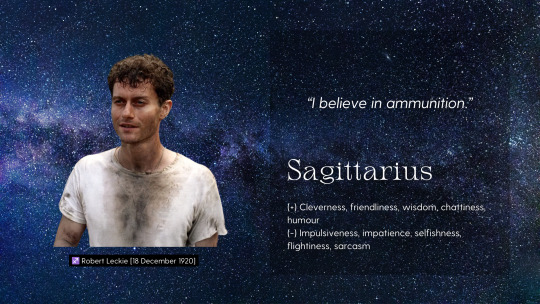
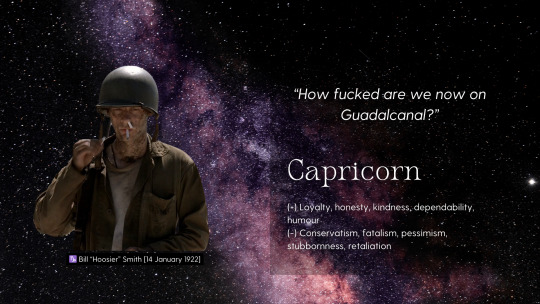
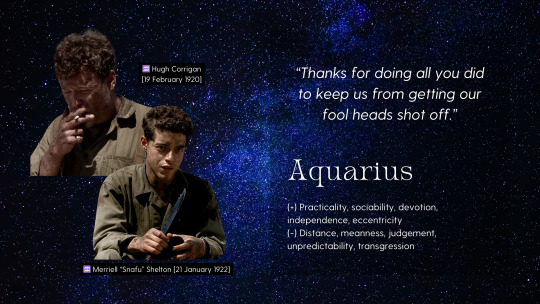


BOBSTROLOGY 2: THE PACIFIC BOOGALOO
Another completely serious presentation by @pegasusdrawnchariots and oatflatwhite
written version under the cut!
♈️ Edward “Hillbilly” Jones – 1 April 1917 ♈️ Elmo “Gunny” Haney – ?? April 1898 * ♉️ Clifford "Steve" Evanson – 25 April 1926 ♊️ Bill Leyden – 27 May 1926 ♊️ Robert Oswalt – 13 June 1923 ♊️ J. P. Morgan – 20 June 1919 * ♋️ Lewis “Chesty” Puller – 26 June 1898 ♌️ Chuck Tatum – 23 July 1926 * ♌️ Jay De L���Eau – 29 July 1923 ♌️ R. V. "Burgie" Burgin – 13 August 1922 ♌️ Manny Rodriguez – 17 August 1922 ♍️ Andrew “Ack Ack” Haldane – 22 August 1917 ♍️ Sidney Phillips – 2 September 1924 ♎️ Vera Keller – 13 October 1923 ♎️ Lew “Chuckler” Juergens – 22 October 1918 ♏️ John Basilone – 4 November 1916 ♏️ Eugene Sledge – 4 November 1923 ♏️ Wilbur “Runner” Conley – 6 November 1921 ♐️ Robert Leckie – 18 December 1920 ♑️ Bill “Hoosier” Smith – 14 January 1922 ♒️ Merriel “Snafu” Shelton – 21 January 1922 ♒️ Hugh Corrigan – 19 February 1920 ♓️ Lena Riggi Basilone – 7 March 1913
2 Aries 1 Taurus 3 Gemini 🥈 1 Cancer 4 Leo 🥇 2 Virgo 2 Libra 3 Scorpio 🥈 1 Sagittarius 1 Capricorn 2 Aquarius 1 Pisces
7 🔥 4 🪨 7 💨 5 💧
6 cardinal 10 fixed 7 mutable
14 masculine 9 feminine
* Gunny Haney's day of birth is not known; we went with Aries on vibes * J. P. Morgan's birthday was taken from The Pacific wiki but we couldn't verify it elsewhere (or whether he was actually a real dude?) * Chuck Tatum is a cusp and we assigned him Leo based on his city of birth if he had been born at noon; also on vibes
** Other characters in The Pacific are based on people from Leckie and Sledge's memoirs, but their names are either changed or they are only referred to by surname and quite unidentifiable, based on my (oatflatwhite's) original search (which was not exhaustive!). Ronnie Gibson and Stella Karamanlis, for example, seem to be based off of real people Leckie encountered during the war, but were not their actual names. Others, like minor officers in both K and H companies, and the doctors Leckie sees, I just couldn't track down. We could locate the birthdays of Sledge's family (brother and parents) but since we couldn't do the same for Leckie and Basilone, we left them off this list. They're two more Scorpios and another Virgo, by the way.
*** And if you've read this far, @pegasusdrawnchariots assigned Stella Leo based on vibes :-)
#the pacific#hbo war#thepacificedit#hbowaredit#bobstrology#liz makes things#robert leckie#eugene sledge#john basilone#et cetera et cetera#phew what an undertaking
89 notes
·
View notes
Text
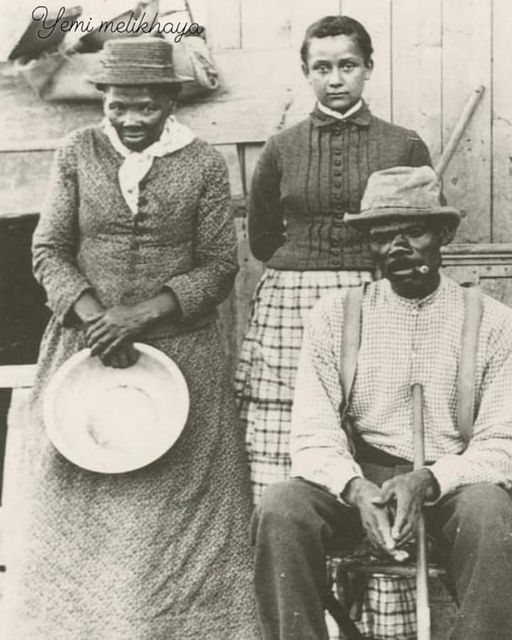
1887 Photograph of Harriet Tubman, her Husband Nelson Davis, and Their Adopted Daughter Gertie.
Harriet Tubman married her second husband Nelson Davis on March 18, 1869 with whom they adopted daughter, Gertie. Born in North Carolina, her husband had served as a private in the 8th United States Colored Infantry Regiment from September 1863 to November 1865. Nelson died on October 14, 1888 of tuberculosis.
The great Harriet Tubman died of pneumonia in 1913 at the age of 93 surrounded by family members whom she told “I go to prepare a place for you.”
325 notes
·
View notes
Text

René Clément, March 18, 1913 - March 17, 1996.
With Jean-Paul Belmondo and Alain Delon during the making of Is Paris Burning? (1966). Photo by Jack Garofalo.
70 notes
·
View notes
Text


Harold J. Stone (March 3, 1913 – November 18, 2005)
12 notes
·
View notes
Text
The Grand Duchesses and sweets
Scientists working with the dental remains of three of the Grand Duchesses concluded that their dental structure and fillings suggested they were “fond of sweets”.
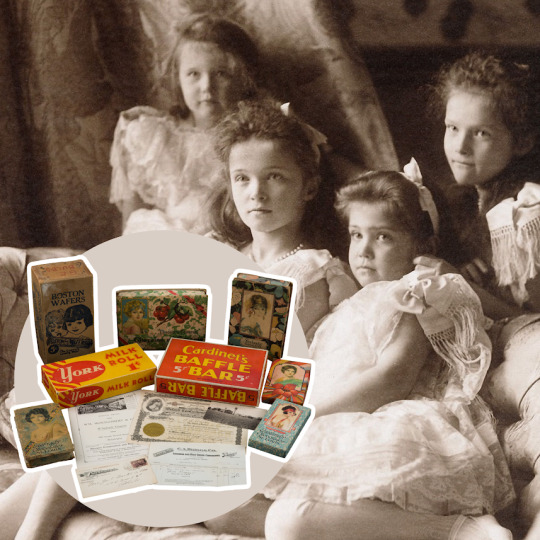
A favourite of the Grand Duchesses in the palace was Jim Hercules, an African American servant. The Grand Duchesses’ aunt, Olga Alexandrovna, recalls how Jim would spend his “annual holiday in the States and brought back jars of guava jelly as presents for the children.” Jim also brought them other American candy, and toys for their playroom.
The head baker at the palace, Ermolaev, specialised in making pastries and confectionery, and even the yacht Standart was equipped with a confectionery kitchen. However, the children still enjoyed the novelty of foreign imported sweets. In June 1912, it was reported that “when the Grand Duchess Anastasia, daughter of the Emperor Nicholas of Russia, celebrates the eleventh anniversary of her birth on June 18, she will have an abundant supply of American candy. Curtis Guild Jr, American Ambassador to Russia, left New York Tuesday on the Kaiser Wilhelm der Grosse with a trunkful of candy for her.”
In 1916, the Governor of Tver sent the Grand Duchesses pryaniki, a sweet gingerbread cookie biscuit that the region specialised in manufacturing. Sweets were also discussed by fans of the Grand Duchesses: Dolores Sybilla Adam, a teenager from California, once wrote a fan mail letter to Olga Nikolaevna, writing “I should dearly love to make you a great big box of candy and send it to you, from your friend, away in sunny California.”
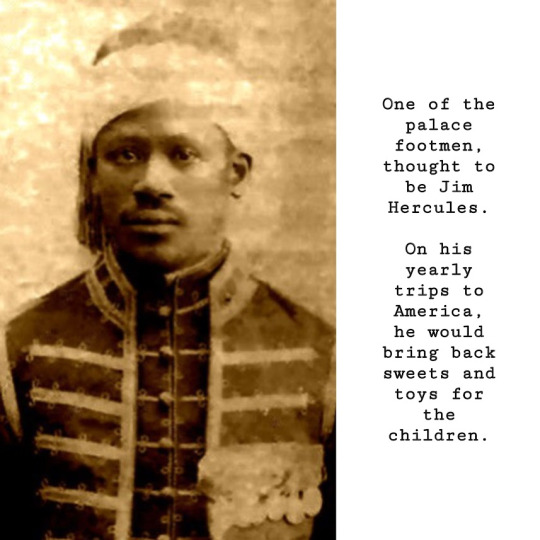
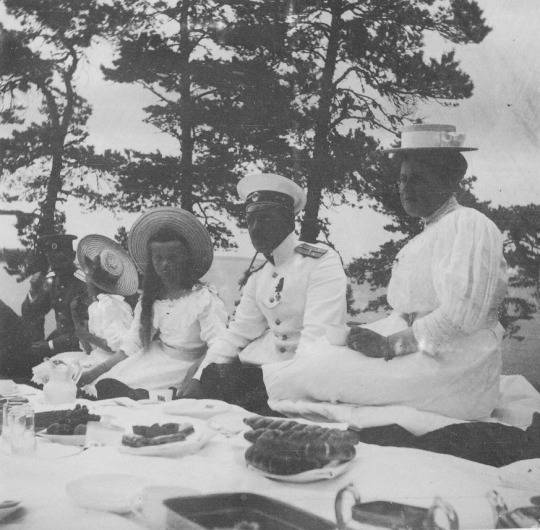

A love for sweets ran in the family. Conservators recently found a half-chewed piece of sugar paste candy hidden within the dress of the children’s aunt, Grand Duchess Xenia Alexandrovna!

Sources:
Correspondence of the Russian Grand Duchesses: Letters of the Daughters of the Last Tsar, George Hawkins, ([n.p], Independently Published, 2020) [no page numbers], letter beginning Dolores Sybilla Adam to Olga and Tatiana, Nov 25 1913, Amazon Kindle eBook
LUNCH ON THE BALCONY: Recipes from the table of Russia’s last imperial family, Helen Azar, ([n. p.], Independently Published, 2022), Ch. ‘The Confectionary’, [n. p. n] Amazon Kindle eBook
The Many Deaths of Tsar Nicholas II, Wendy Slater, (Oxfordshire: Routledge, 2007), Ch. ‘True Crime’, p. 40, Google Books eBook
Anon. ‘RomanovsOneLastDance’, ‘June 1912’, Tumblr, 25 March 2016
Nicholas and Alexandra, Robert K. Massie, (New York: Laurel, 1985), Ch. ‘The Tsar’s Village’, p. 123, archive.org eBook
Helen Azar, ‘LUNCH ON THE BALCONY: Recipes from the table of Russia’s last imperial family’, (2022), Ch. ‘The Confectionary’
Photos: Public domain, GARF, Heritage Auctions, HA.com, Russia Beyond
#olga nikolaevna#tatiana nikolaevna#maria nikolaevna#anastasia nikolaevna#otma#romanovs#sources#romanov#russian history#sweets#confectionary#cookies#my own
99 notes
·
View notes
Note
No stop poor haruko enomoto, I feel terrible for her 😭
Why? I don't. She never complained about her life with Doppo Kunikida, and she was, by all accounts, devoted to him, so I get the inkling she doesn't need, and wouldn't have cared for, our pity.
I know it feels crass and dismissive, and I understand it's difficult to reconcile agency with the constraints of oppression and societal pressure, but I don't consider her devotion to her husband pitiable.
She chose him, and it certainly wasn't because she needed him (she outlived him by several decades, during which she supported her family herself) or because he was pretty (he was, but so was she) or because he could provide for her (he was broke when he met her and stayed broke for quite some time) or because her parents liked him (no one's parents liked Doppo Kunikida; knowing this, he tried to court her in secret but her mother was suspicious and returned a book he sent Haruko unopened) or because he displayed any semblance of emotional regulation (he showed up drunk and angry to her home when her mother returned the book). Nevertheless, for reasons we don't need to understand, she sent him an amethyst crucifix and an impassioned letter about her admiration for the emotion in his writing, and married him in August.
She found someone worth her devotion in that undomesticated, tumultuous, restless, combative, arrogant, lyrical, mawkish, idealistic, fervent man. She didn't devote herself lightly, but wholly, unflinchingly, no matter Doppo Kunikida's wavering heart. By which I mean his infidelity, sure, but more pressingly, I mean that Doppo Kunikida fretted and lamented and tore at his own hair over the contradictions between his values and his inclinations, his sincerity and his arrogance, his potential and his indirection. Maybe that was part of it; his river could rage and his fire could burn, but she had an amethyst heart that could withstand him, and, at least sometimes, ground him too. He experienced his most tranquil years as her husband, and I don't think that's incidental.
Regardless, I choose to defer to her agency and judgment, and I won't patronize her over choices she made as a whole, thoughtful person based on the impressions of her that Katai Tayama offered Japanese naturalism.
The sum of her life was also not her husband's indiscretion. She was an accomplished and prolific writer, and a supporting member of Bluestockings, Japan’s first all-women literary magazine.
A non-exhaustive list of her works (the titles are VERY roughly machine translated, forgive me):
"Sada-chan" (January 1903)
"Ryori-kai" (June 1906)
"Shuhi" (August 1906)
"Otsuyu" (October 1907)
"Premonitions" (November 1907)
"Tosei" (February 1908)
"Dokuho at Home "(July 1908)
"Bankruptcy" (August 18, 1908 - September 30, 1908)
"Model" (November 1908)
"Shingokoro" (December 1908)
"Grandson" (January 1909)
"News" (January 1909)
"Kohachijo" (May 1909)
Kunikida Doppo and Haruko co-authored "Golden Forest" (December 1909) (includes Doppo's work and Haruko's "Bankruptcy")
"Quail" (December 1910)
"Sister" (June 1911)
"Cat's Fleas" (September 1911)
"Hagi no Yado" (September 1911)
"Osato" (June 1913)
"Sayachidori" (March 1914)
She became the head of her family at the age of 16, when her father died. She worked in a department store, and taught flower arranging. Her second daughter, Midori, took care of her in her final years. Doppo Kunikida died in 1908, but Haruko Enomoto lived until 1962. She lived an entire lifetime without him, before and after him.
Haruko Enomoto was not her husband's unfortunate wife; she was a gem by her own merit, not despite him, but as demonstrated through her steadfastness in their marriage, her intrepid writing career that challenged the literary establishment, and her tenacity through becoming the head of her family twice over.
They also had four children in a relatively short time frame, during some of which he was ill considering their youngest was born three months after he died, so I like to think he at least gave her great dick. Call me an idealist, I guess.
#haruko enomoto#all the blood that he wasn't coughing up went into what i hope was the best sex of their lives for her to remember him by#doppo kunikida#modern japanese literature
11 notes
·
View notes
Text

OTD in Music History: Immmortal composer Franz Peter Schubert (1797 - 1828) is born in Vienna. Schubert showed tremendous gifts from a very early age. His father gave him violin lessons and his elder brother gave him piano lessons, but Schubert quickly eclipsed both of them and went on to study with famed pedagogue (and former rival of W.A. Mozart [1756 - 1791]) Antonio Salieri (1750 - 1825). In 1821, Schubert was admitted to the then-recently-formed Viennese Gesellschaft der Musikfreunde ("Society of the Friends of Music") as a performing member, which helped him to establish his name as a local composer. Because of his tragically early death, however, he only ever gave a single concert dedicated to his own works, in March 1828. Despite passing away at the age of just 31, Schubert left behind a shockingly vast musical oeuvre. In a career that spanned just a decade and a half, he managed to compose more than 600 secular vocal works (mainly German art songs known as “lied”), seven complete symphonies, a substantial amount of sacred music including six masses, numerous operas (none of which still hold the stage), and large bodies of both solo piano music and chamber music. Nevertheless, it was only in the final year and a half of his life (perhaps not coincidentally, following the death of his great colleague and neighbor Ludwig van Beethoven [1770 - 1827]) that he truly came into his full flowering as a composer of instrumental music cast in larger forms. Speaking of that period, Benjamin Britten (1913 - 1976) later marveled at what he dubbed “the most miraculous 18 months in the entire annals of musical history.” PICTURED: A photograph of Schubert's death mask, which has unfortunately now been lost and is presumed to be destroyed. As such, this photograph is the best surviving likeness of Schubert.
#classical music#opera#music history#bel canto#composer#classical composer#aria#classical studies#maestro#chest voice#Franz Schubert#classical musician#classical musicians#classical history#history of music#historian of music#musician#musicians#diva#prima donna
2 notes
·
View notes
Text
Song of the day
do you want to know the history of a folk song? submit an ask or dm me and I'll cover it
youtube
"I Ride an Old Paint/Leavin' Cheyenne" Carl Sandburg, 1937
"I Ride an Old Paint/Leavin' Cheyenne" is a traditional cowboy ballad, first published in 1916 by John Lomax in "Cowboy Songs and Other Frontier Ballads"
and later, in 1921, by Nathan Howard "Jack" Thorp in "Songs of The Cowboys"
and even later in 1927, by Carl Sandburg in " The American Songbag"
all 3 of them propose different origins to the song, which demonstrate a larger story-
Carl Sandburg says in The American Songbag that he heard it from a singer who heard it from a cowhand traveling to the border with some friends:

Jack Thorp says that he heard it from a cowboy in Pecos City, Texas, but doesn't say who.

Luckily, with John Lomax, there actually is a thread to pull with the origins of this song.
John Lomax had learned the song from Cowpoke Jess Morris who at multiple times had said that he learned the song as a child working on his father's ranch from Freed-man Cowboy Charley Willis, a famous Black cowboy and employed by Morris' Father, E.J Morris.
in 1928, he says that he learned it working at his father's ranch at a young age but doesn't specify Charley Willis.

Amarillo Sunday News-Globe (Amarillo, Tex.), Vol. 19, No. 133, Ed. 1 Sunday, March 18, 1928 (p. 2)
and in 1952, where he specifies that it was Charley Willis who taught him.
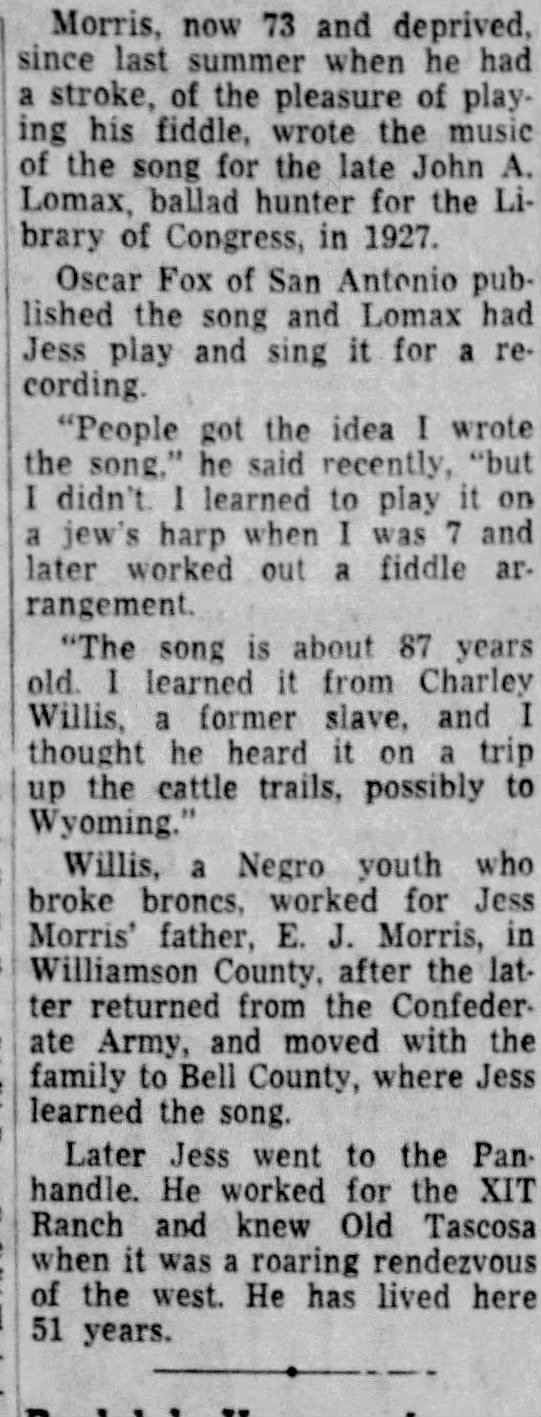
Fort Worth Star-Telegram (Fort Worth, Tex.) Sun, Jun 01, 1952. (p. 18)
In J. Morris' unpublished manuscript and other correspondence that's been archived at the American FolkLife Center at the Library of Congress, he talks about the life of Charley Willis. He was an amazing cowhand because of his soothing voice, how he was leaving from Texas to Wyoming, how he might have actually had a horse called "Old-Paint." If you're interested in learning more about that, i recommend:
this short article
this npr article
and chapter 12 of this book

While neither Charley Willis nor his son were ever recorded singing this song, in 1942, Jess Morris was finally recorded by John Lomax, and this version is probably as close to the version by Charley Willis as we're going to get
youtube
it seems that in 1913, Jess Morris recorded the song, but this recording no longer exists, but here's a tag for it.

Steven Wade, The Beautiful Music All Around Us (2012) p.345, The American Folklife Center, Library of Congress
as with many things, however, one of the first recorded renditions of this song belongs to Harry McClintock in 1928
based on the similar lyrics in all of the older versions, I believe this song is actually a Descendant of "The Wagoner's Lad" (also called "Lovely Nancy" or "My Horses Ain't Hungry" sometimes) and belongs to the "On Top of Old Smokey" family of traditional folk music.
take a look at the lyrics from the 3 books it was first recorded in
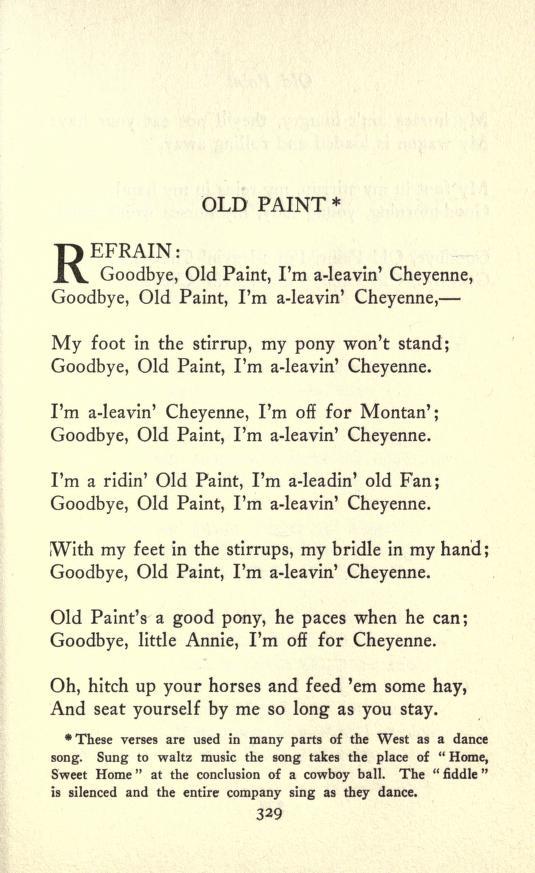


While Sandburg's is pretty different, Lomax and Thorp's versions both contain lyrics that are also in "The Wagoner's Lad" as well as other similarities, as do Jess Morris' version and Harry Mcclintock's.
here are "The Wagoner's Lad" lyrics to compare with

"The Wagoner's Lad" was first compiled in 1906 by Cecil Sharp and published in 1917
where Sharp explains that it was much much older and that the Appalachian culture was particularly skillful at persevering traditional folk songs. this song also probably comes from even older, more traditional folk tunes from English folk music.
it was first recorded in 1926 and performed by Kelly Harrel as "My Horses ain't Hungry"
my favorite rendition is "Pretty Nancy" by Jean Ritchie in 1971
Getting back on the topic of "Old Paint," my favorite version of all time is by contemporary artist Colter Wall in 2023, who combines the best aspects of the traditional song's various melodies and lyrics and really makes the story of the song stick out as a bittersweet masterpiece.
Anyway, I don't know who wrote "Old Paint". like with all folk music, it's very likely that it has multiple origins or that Charley Willis learned it from someone else. Regardless, I'm happy that he's credited with writing the song. black history in the American West is so often erased that whatever shred of recognition that is given to black cowboys is something to hold onto.
#Youtube#John Lomax#jess morris#Harry mcclintock#carl sandburg#jean ritchie#colter wall#cowboy ballads#country#old country#Appalachian folk#folk#cowboy#black history#charley willis#cowpoke#american history#history#music history#folk history#song of the day
4 notes
·
View notes
Text



Dorothy Campbell Hurd Howe was born on March 24th 1883.
Born as Dorothy Lee Campbell at North Berwick, she spent her childhood on the town’s famous links, where her paternal grandfather and eight uncles all played. Dorothy is said to have taken her first swing when she was 18 months, and by age five, was playing matches against her older sisters.
Campbell did not evolve into a top player until her later teens, when she changed what had been a half swing into a full one. In 1905, Campbell won her first Scottish Ladies title. Played at the North Berwick links, more than 4,000 people watched her win the final on the 19th hole.
She repeated in 1906 and 1908. The next year she entered the U.S. Women’s Amateur for the first time and won at the Merion Cricket Club. When she returned to achieve her first victory in the British Women’s Amateur Championship at Royal Birkdale, it was an unprecedented double.
Her favorite club was a goose-necked mashie she called “Thomas.” It was “Thomas” that she gave credit to for her American-British double for in the semifinal at Birkdale she used the club to hole out from a dead stymie at a crucial point in the match. In the final of the 1921 North and South championship at Pinehurst, “Thomas” holed two shots.
After her flurry of national titles, Campbell married and her golf career hit a fallow period. When she lost the final of the 1920 U.S. Amateur to Alexa Stirling, it appeared to be her last hurrah. But in 1923, seeing that many women were out-driving her by using a more modern technique, she concluded that her game needed updating.
She changed her swing from a stiff-wristed, sweeping-type motion that produced a straight but short left-to-right shot to a more athletic action in which hand action played an important part. Working with George Sayers, the pro at Merion who was also from North Berwick, she forced herself to switch from the baseball to the Vardon grip. After 10 months of work, Hurd was literally a new player.
At the 1924 U.S. Amateur at Rhode Island C.C., she rolled through the field, ultimately defeating Mary K. Browne, the national lawn tennis champion of 1912 and 1913, 7 and 6, in the final.
Although it was Hurd’s last championship, she was far from finished as a golfer. In 1926, she set out to surpass the record for fewest putts in 18 holes, 21, which had been set by Walter J. Travis. At the Augusta C.C., Hurd came to the 18th hole with 19 putts, when she holed out from off the green using “Thomas,” her famous mashie.
She married Jack V. Hurd in Wentworth, Ontario, Canada on February 11, 1913. Jack V. Hurd was a steel magnate living in Pittsburgh, Pennsylvania, and a member of Oakmont Country Club. She won many of her titles as Mrs. J. V. Hurd, but she and Hurd were divorced in 1923.
She died in a railway accident on March 20, 1945, falling off a platform and into the path of an oncoming train. Her death certificate shows her full name to be Dorothy Lee Howe. The principal causes of death were a skull fracture and avulsion of her right arm.
4 notes
·
View notes
Text
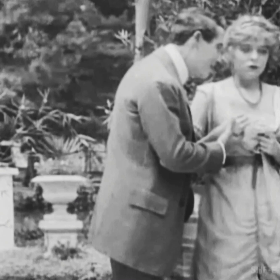
Petition for divorce for Henry B. Walthall, "Little Colonel" of the movies, from his wife was on file here today. The charge is desertion. Walthall is understood to be in Los Angeles. Papers were filed by his attorney.
-"'Little Colonel' of Movies Asks Divorce From Wife," Eugene Register-Guard, September 11, 1918
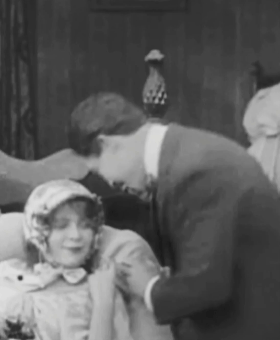
Less than two minutes after he entered the courtroom yesterday Henry B. Walthall, moving picture actor, was granted a divorce from Mrs. Isabelle Harrington Walthall in the circuit court. Walthall charged his wife with desertion, stating she left him March 18, 1916. Mrs. Walthall is said to be living in New Jersey.
-"Divorce for Henry Walthall," Warsaw Daily Times, November 16, 1918
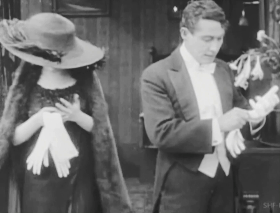
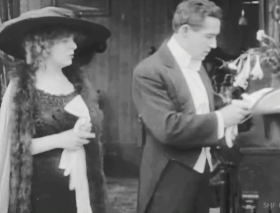
Henry Walthall married Miss Mary Charleston five days after he had been granted a divorce from Mrs. Isabelle Harrington in 1918. They were married at Crown Point. Judge H.H. Loring, Valparaiso, Ind., pronounced Walthall's second marriage illegal.
-"Three Movie Weddings Probed; Search For Bride Is Recalled.," St. Petersburg Times, May 26, 1922
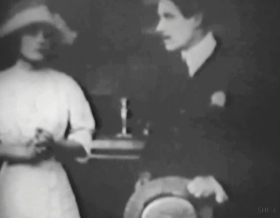
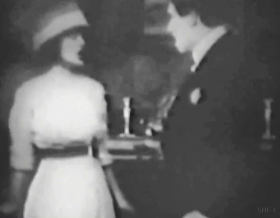
He married his leading woman, Mary Charleston, in Indiana, ten days after he was divorced from Irene Fenton. He says:
"There are absolutely no grounds for investigation into my second marriage. I married my first wife, Isabelle Fenton, fifteen years ago. We couldn't get along, and separated. I obtained a divorce at Chicago five years ago. I was given a final decree with the provision that I would not marry again in that state. The Indiana judiciary decided that my second marriage is entirely legal."
-"The Love Troubles of a Perfect Lover," The Norwalk Hour, July 10, 1922
※ Here's Walthall lied that he had a divorce from his wife Isabelle Fenton 5 years ago but actually it was 4 years ago. It seems like he was trying to deceive his daughter's age.
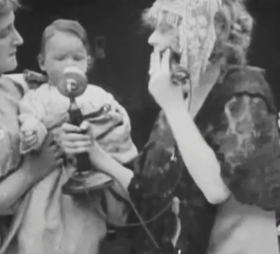
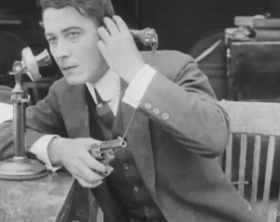
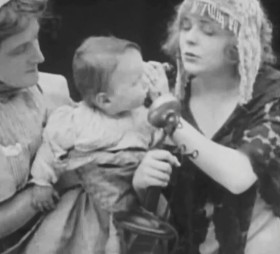
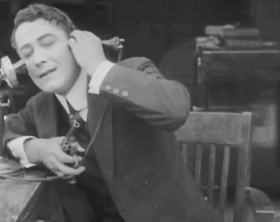
Marguerite Clark, once as noted in the film world as Mary Pickford, and Mary Charleston, star of the old Vitagraph company, now are happily married. The former is the wife of Harry Williams of New Orleans, and the latter married Henry B. Walthall, the actor.
"I have found more happiness in my home than I ever could have found in the vain glory of seeking personal fame," says Mrs. Walthall.
-"Many Stars, Once Famous, Now Are In Poverty And Obscurity," The Southeast Missourian, September 15, 1925
Henry Walthall's daughter Mary Patricia was born on her father's 40 year old birthday. (March 16, 1918) But the baby's mother wasn't Walthall's wife. Her mother was Mary Charleson.
When Henry Walthall divorced his wife Isabelle Fenton in Chicago, he received an order from the judge prohibiting him from remarrying within the state for one year. So he went to Indiana and remarried Mary Charleson in November 20, 1918. It was five to ten days after divorcing his wife, Isabelle Fenton.
In other words, Henry Walthall already had an illegitimate child. That was a reason why Walthall had to divorce Isabelle Fenton and why he had to remarry Mary Charleson so quickly after the divorce.
gifs: Blanche Sweet and Henry Walthall in Death's Marathon (1913, D.W. Griffith) / Claire McDowell and Henry Walthall in Two Daughters of Eve (1912, D.W. Griffith)
#henry b. walthall#henry walthall#death's marathon 1913#two daughters of eve 1912#isabelle fenton#mary charleson#mary patricia walthall#i adore you very much mr. walthall but you were the worst man i've ever loved#기사 인용
2 notes
·
View notes
Text

"WILL ENGAGE A PAVING EXPERT," Kingston Daily Standard. March 18, 1913. Page 2. --- Board of Works Will Get Advice. --- In View of Exceptional Work in Connection With Rails This Step Will be Taken. --- The City Council at its regular meeting last night decided to engage the services of an expert engineer, to prepare the plans and give expert advice in regard to the paving of King and Princess streets. In view of the fact that the department of the City Engineer is so limited, and that there are very few men in Canada who are expert in the matter of paving in connection with street railway tracks, it was considered adviseable by the Board of Works to secure an acknowledged expert on this subject before the Council took any definite step in the matter.
This matter was brought to the attention of the members of Council in a report which was made by the Board of Works subsequent to the re- gular report, and which was not in printed form. This was a matter of comment by Mayor Rigney, who pointed out that the procedure was any- thing like businesslike. He intimated that the Board had since Thursday last to prepare its report and that there was no excuse for it bringing the matter to the attention of Council in this form. He stated that it was not fair to Council to expect the members to grasp the meaning of a report from the reading of the secretary. He advised the chairman to obey the rules of Council in this regard.
Ald. Fair explained that the matter had been brought up at a meeting subsequent to the regular meeting and that there had been no time to embody it in the regular report. In reply to questions he stated that it was estimated that the cost of such expert advice as was required. would be in the neighborhood of $200 and expenses, the expenses not to exceed about $65. The chairman pointed out that the Board had. thought this action advisable in view of the unusual expenditure and in consideration of the fact that the engineering staff was very limited.
This clause was passed without further discussion.
The City Council also adopted the recommendation of the Board of Works in regard to the paving program for the year. The following streets are to be paved with a permanent pavement on a concrete base Johnson street from Ontario to Wellington street; King street from Clarence to William street; and Wellington street, from Clarence to William street.
The Council last year passed on the laying of an asphaltic macadam roadway on Wellington street to the Park and this will be proceeded with this year in conjunction with the continuation of the work on Barrie street, from Union street to Princess street.
#kingston ontario#municipal politics#municipal government#street railways#1912-1913 kingston street paving#road paving#road building#road work#streetcars#board of works#rule of the experts#engineering expertise
2 notes
·
View notes
Text

Harriet Tubman married her second husband Nelson Davis on March 18, 1869 with whom they adopted daughter, Gertie. Born in North Carolina, her husband had served as a private in the 8th United States Colored Infantry Regiment from September 1863 to November 1865. Nelson died on October 14, 1888 of tuberculosis.
The great Harriet Tubman died of pneumonia in 1913 at the age of 93 surrounded by family members whom she told “I go to prepare a place for you.”
#harriet tubman#northcarolinaborn#blackhistory#1869#unitedstatescoloredinfantry#died of pneumonia#age93
9 notes
·
View notes
Text
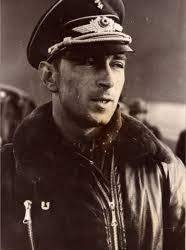
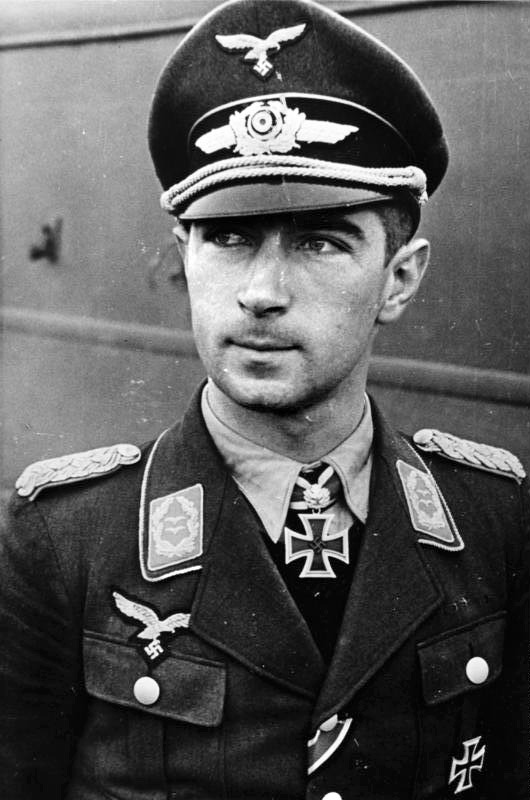
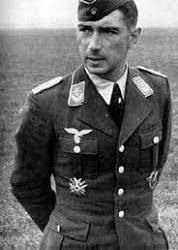
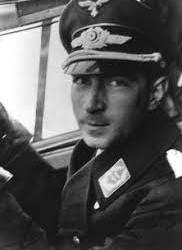
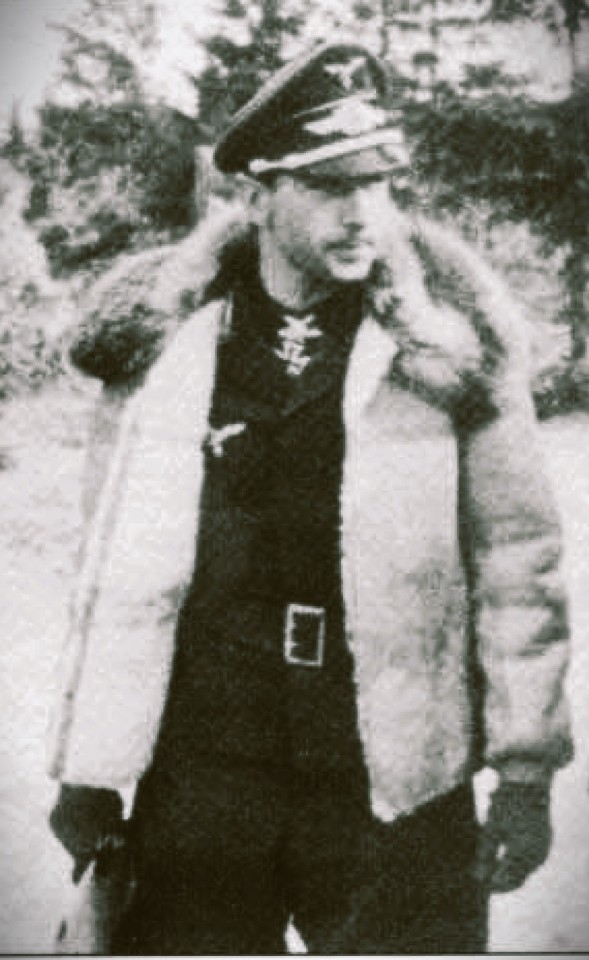
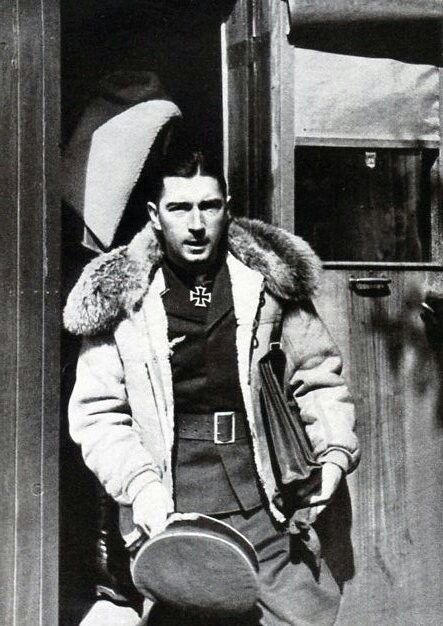
Werner Mölders
(18 March 1913 – 22 November 1941)
World War II German Luftwaffe pilot, wing commander, and the leading German fighter ace in the Spanish Civil War. He became the first pilot in aviation history to shoot down 100 enemy aircraft and was highly decorated for his achievements. Mölders developed fighter tactics that led to the finger-four formation. Mölders joined the Luftwaffe, the air force of Nazi Germany, in 1934. In 1938 he volunteered for service in Germany's Condor Legion, then supporting General Francisco Franco's Nationalist side in the Spanish Civil War, and shot down 14 aircraft. Following the start of World War II in 1939, he took part in the "Phoney War" of 1939–1940, the Battle of France of May to June 1940, and the Battle of Britain (July 1940 onwards). With his tally standing at 68 victories, Mölders and his unit, the Jagdgeschwader 51 (JG 51), transferred to the Eastern Front in June 1941 for the opening of Operation Barbarossa, achieving 101 victories by mid-July 1941. Prevented from flying further combat missions for propaganda reasons, at the age of 28 Mölders was appointed Inspector of Fighters. While inspecting the Luftwaffe units in the Crimea he received orders to return to Berlin to attend the state funeral of Ernst Udet, a Luftwaffe general and World War I flying ace. The aircraft in which Mölders was traveling as a passenger to Berlin experienced an engine failure and attempted an emergency landing. It crashed at Breslau, killing Mölders and two others.
#werner molders#wwii#german fighter pilot#history#war#people#wwii germany#germany#legend#reality#life#world
5 notes
·
View notes
Text

René Clément, March 18, 1913 - March 17, 1996.
With Alain Douarinou and Alain Delon on the set of Joy House (1964).
19 notes
·
View notes